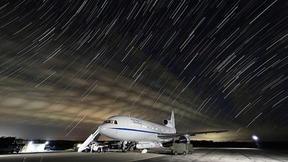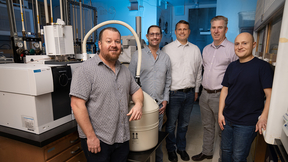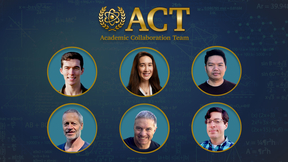Back
Defense
Livermore teams honored with Defense Programs Awards of Excellence
Lawrence Livermore National Laboratory (LLNL) recently recognized three teams with the National Nuclear Security Administration’s (NNSA) Defense Programs Awards of Excellence (DPAE) for work completed during calendar year 2023. In total, 93 LLNL employees were honored for their exceptional contributions to Defense Programs. Established in 1982, the Defense Programs Awards…
Big Ideas Lab Podcast explores legacy and innovation of Site 300
Lawrence Livermore National Laboratory (LLNL) has released a compelling new episode of the Big Ideas Lab Podcast, focusing on the storied history and groundbreaking advancements of the Site 300 Experimental Test Site. Listen on Apple or Spotify. Situated on 7,000 acres in the rural foothills approximately six miles southwest of downtown Tracy and 15 miles southeast of…
Making room to modernize Outdoor Firing Facility imaging diagnostic capabilities
There is a new camera room nestled in the bunker beneath Lawrence Livermore National Laboratory’s Outdoor Firing Facility (OFF) “table” where explosives are tested. The camera room was a grassroots effort by the camera team to create efficiencies by modernizing operations and creating valuable hands-on training space. “We expect we’ll save between half a day to two days on…
LLNL’s newest Machinist Apprenticeship Program graduates embark on next chapter of careers
In a ceremony tinged with tradition, the latest cohort from Lawrence Livermore National Laboratory’s (LLNL’s) esteemed Machinist Apprenticeship Program recently celebrated their graduations at a private ceremony. The event, held at a new venue for the first time in decades — Livermore’s Zephyr Bar and Grill — was attended by family members, friends, mentors, past…
Franklin Miller awarded Livermore’s 2024 John S. Foster Medal
Lawrence Livermore National Laboratory (LLNL) Director Kim Budil today announced that the 2024 John S. Foster, Jr. Medal is awarded to Franklin Miller, a principal at The Scowcroft Group. The ninth recipient of the prestigious Foster Award, Miller is recognized for his exceptional and inspirational career dedicated to national security, defense policy and international…
LLNL looks to revolutionize 3D printing through microwave technology
In the rapidly evolving world of 3D printing, the pursuit of faster, more efficient and versatile production methods is never-ending. Traditional 3D printing techniques, while groundbreaking, are often time-consuming and limited in the kinds of materials they can use as feedstock. But, through a new process a Lawrence Livermore National Laboratory (LLNL) team is calling…
All ears on the Big Ideas Lab podcast
Lawrence Livermore National Laboratory (LLNL) has big ideas and is showing the world in the Big Ideas Lab weekly podcast that takes listeners behind the fences and into its heart. “This is where big ideas come to life,” said Lab Director Kim Budil. “To do this, we bring together dynamic teams of many different disciplines — laser physicists and materials scientists and…
LLNL’s Tammy Ma shares fusion energy vision with TED
What would you do with the largest laser in the world? That’s the question Lawrence Livermore National Laboratory (LLNL) physicist Tammy Ma posed to the audience on the mainstage at the influential TED conference held in April in Vancouver. In the talk, which was publicly released today, Ma shared her answer: bringing about a world powered by laser-based fusion energy,…
Lab team surveys Site 300 for hotspots
In the mid-afternoon of Saturday, June 1, the Corral Fire ignited near the Lab’s Site 300. It made headlines for days and kicked off this year’s fire season. The blaze raced across more than 14,000 acres in just 24 hours, incinerated a structure and badly burned two fire personnel. Early Sunday morning, the Lab’s Associate Principal Deputy Director Sandra Brereton reached…
Two LLNL physicists honored for international collaboration
Lawrence Livermore National Laboratory (LLNL) physicists Hye-Sook Park and George Swadling, along with Anna Grassi of France’s Sorbonne University and former Lawrence Fellow Frederico Fiuza of Portugal’s Técnico Lisboa, received the 2024 Lev D. Landau and Lyman Spitzer Jr. Award for Outstanding Contributions to Plasma Physics. The award is jointly sponsored by the Plasma…
When experiments go quiet: maintaining the National Ignition Facility
For two weeks last April, the lasers at Lawrence Livermore National Laboratory’s National Ignition Facility stopped firing. Experiments may have been on pause, but the facility was anything but quiet. “To do world-class science, you need a world-class facility. And you can’t just maintain that facility, you must anticipate problems and seek out improvements,” said Stanley…
FAA awards first approval for drone swarm testing
Lawrence Livermore National Laboratory’s (LLNL) Autonomous Sensors team has received the Federal Aviation Administration’s (FAA’s) first and — to date — only certificate of authorization (COA) allowing autonomous drone swarming exercises on the Lab main campus. These flights will test swarm controls and sensor payloads used in a variety of national security applications…
LLNL leads successful execution of subcritical experiment in Nevada
Lawrence Livermore National Laboratory (LLNL) recently led the successful execution of the first U.S. subcritical experiment (SCE) since 2021 at the Principal Underground Laboratory for Subcritical Experimentation (PULSE) facility, formerly known as the U1a Complex, at the Nevada National Security Site (NNSS). The last LLNL-led SCE was in February 2019. The experiment —…
Manufacturing optimized designs for high explosives
When materials are subjected to extreme environments, they face the risk of mixing together. This mixing may result in hydrodynamic instabilities, yielding undesirable side effects. Such instabilities present a grand challenge across multiple disciplines, especially in astrophysics, combustion and shaped charges — a device used to focus the energy of a detonating explosive…
LLNL’s El Capitan debuted on new Top500 list of world’s most powerful supercomputers
Three new systems currently or soon-to-be sited at Lawrence Livermore National Laboratory (LLNL) on Monday debuted on the latest Top500 list of most powerful supercomputers in the world, including the first portion of the exascale machine El Capitan. Unveiled at the International Supercomputing Conference in Hamburg, Germany, the June 2024 Top500 lists three systems with…
Lab to provide optical payload for upcoming U.S. Space Force mission
Lawrence Livermore National Laboratory’s (LLNL) Space Program is now building an optical space domain awareness payload for an upcoming mission by the U.S. Space Force. The planned mission, known as VICTUS HAZE, will be a tactically responsive space mission to demonstrate the ability to rapidly characterize an on-orbit threat. The U.S. Space Force selected Long Beach,…
Hot stuff: A new thermal pathway for a high explosive
TATB (1,3,5-triamino-2,4,6-trinitrobenzene) is an important explosive compound because of its extensive use in munitions and world-wide weapons systems. Despite its importance, researchers have been trying to understand its response to temperature extremes for the past 50 years. A Lawrence Livermore National Laboratory (LLNL) team has uncovered a new thermal decomposition…
Strategic Deterrence Academic Collaboration Team awards six scientists to support collaborative research
Six scientists at the Lawrence Livermore National Laboratory (LLNL) were recently granted awards through the Lab’s 2023 Academic Collaboration Team (ACT) annual call for proposals. Awards support university research partners for up to three years to perform research in collaboration with Lab scientists and offer an important way to build long-term connections with…
Unlocking gas phase uranium oxidation is key to nuclear debris modeling
In the quest to understand how nuclear debris forms, a team of scientists at Lawrence Livermore National Laboratory (LLNL) has developed an approach to studying the oxidation mechanism of gas phase uranium in extreme environments. In research recently published in Scientific Reports, the team outlined their work, which combined experimental data from a plasma flow reactor …
Richard W. Mies awarded Livermore’s 2023 John S. Foster Medal
Lawrence Livermore National Laboratory Director Kim Budil today announced that the 2023 John S. Foster, Jr. Medal is awarded to retired U.S. Navy Admiral Richard W. Mies. The eighth recipient of the prestigious Foster Award, Mies has served as a member of the LLNL Board of Governors since 2004 and is recognized for his exceptional and inspirational career dedicated to…

























